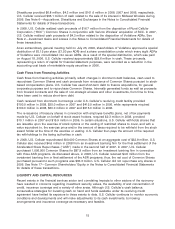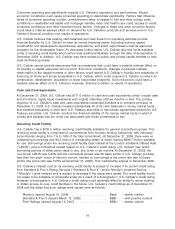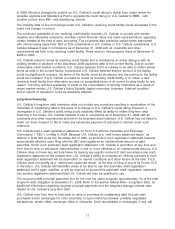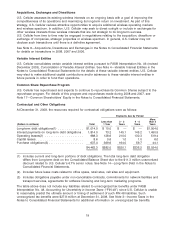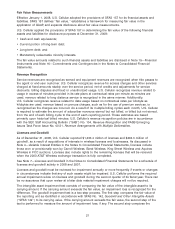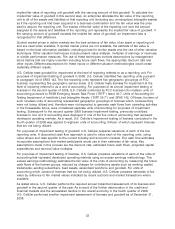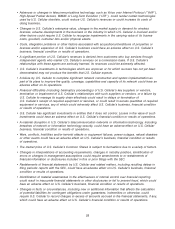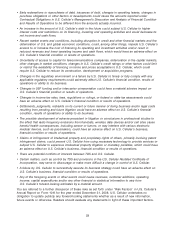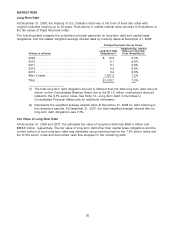US Cellular 2008 Annual Report Download - page 145
Download and view the complete annual report
Please find page 145 of the 2008 US Cellular annual report below. You can navigate through the pages in the report by either clicking on the pages listed below, or by using the keyword search tool below to find specific information within the annual report.For purposes of estimating the fair value of the licenses at December 31, 2008, U.S. Cellular applied the
following methodologies and assumptions:
• Licenses in developed operating markets (five units of accounting)—U.S. Cellular applied an excess
earnings methodology to estimate fair value. Discounted cash flow projections were based on financial
forecasts that applied a long-tem growth rate of 2.0% and a discount rate of 9.5%. If the discount rate
increased by 1% to 10.5%, the total impairment would increase by $181.4 million and if the discount
rate decreased by 1% to 8.5%, the total impairment would decrease by $233.7 million.
• Licenses that are not being utilized (thirteen units of accounting)—U.S. Cellular has historically applied
a market approach in valuing these licenses which involved estimating the fair values of these licenses
by reference to recent auctions and market transactions. However, in the fourth quarter of 2008, there
had not been any recent market transactions to provide a reasonable fair value estimate in light of the
decline in the economic environment. As such, the fair value estimates of these licenses that were
prepared in the second quarter of 2008 were assumed to have declined at the same rate as the fair
value of the licenses in developed operating markets.
See Note 7—Licenses and Goodwill in the Notes to Consolidated Financial Statements for the results of
the annual and interim impairment tests.
Property, Plant and Equipment
U.S. Cellular provides for depreciation on its property, plant and equipment using the straight-line
method over the estimated useful lives of the assets. U.S. Cellular depreciates its leasehold improvement
assets associated with leased properties over periods ranging from one to thirty years, which
approximates the shorter of the assets’ economic lives or the specific lease terms. Annually, U.S. Cellular
reviews its property, plant and equipment to assess whether the estimated useful lives are appropriate.
The estimated useful lives of property, plant and equipment is a critical accounting estimate because
changing the lives of assets can result in larger or smaller charges for depreciation expense. Factors
used in determining useful lives include technology changes, regulatory requirements, obsolescence and
type of use. U.S. Cellular did not materially change the useful lives of its property, plant and equipment
in 2008, 2007 or 2006.
Expenditures that enhance the productive capacity of assets in service or extend their useful lives are
capitalized and depreciated. Expenditures for maintenance and repairs of assets in service are charged
to System operations expense or Selling, general and administrative expense, as applicable.
U.S. Cellular reviews long-lived assets for impairment whenever events or changes in circumstances
indicate that the assets might be impaired. The tangible asset impairment test is a two-step process. The
first step compares the carrying value of the assets with the estimated undiscounted cash flows over the
remaining asset life. If the carrying value of the assets is greater than the undiscounted cash flows, the
second step of the test is performed to measure the amount of impairment loss. The second step
compares the carrying value of the asset to its estimated fair value. If the carrying value exceeds the
estimated fair value (less cost to sell), an impairment loss is recognized for the difference.
Quoted market prices in active markets are the best evidence of fair value of tangible long-lived assets
and are used when available. If quoted market prices are not available, the estimate of fair value is
based on the best information available, including prices for similar assets and the use of other valuation
techniques. A present value analysis of cash flow scenarios is often the best available valuation
technique. The use of this technique involves assumptions by management about factors that are highly
uncertain including future cash flows, the appropriate discount rate, and other inputs. Different
assumptions for these inputs or the use of different valuation methodologies could create materially
different results.
There was no impairment of long-lived assets in 2008, 2007 or 2006.
23




